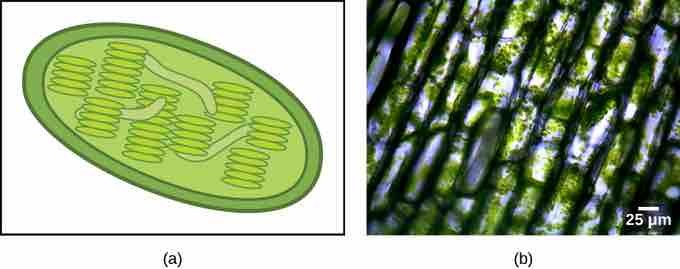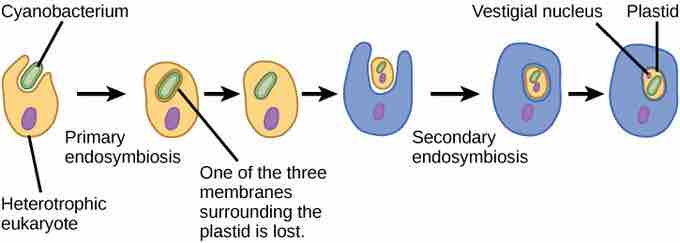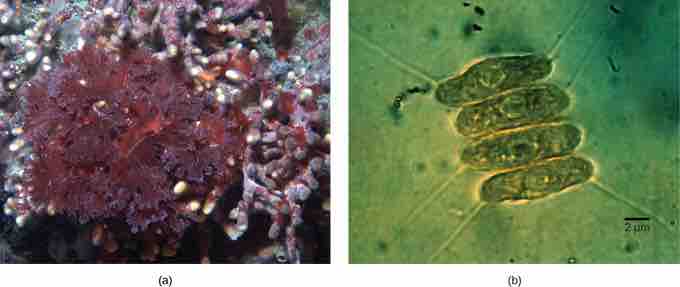Plastids
Some groups of eukaryotes are photosynthetic: their cells contain, in addition to the standard eukaryotic organelles, another kind of organelle called a plastid. There are three type of plastids: chloroplasts, chromoplasts, and leucoplasts. Chloroplasts are plastids that conduct photosynthesis. Chromoplasts are plastids that synthesize and store pigments. Leucoplasts are plastids located in the non-synthetic tissues of a plant (e.g., roots) and generally store non-pigment molecules.
Like mitochondria, plastids appear to have a primary endosymbiotic origin, but differ in that they derive from cyanobacteria rather than alpha-proteobacteria. Cyanobacteria are a group of photosynthetic bacteria with all the conventional structures of prokaryotes. Unlike most prokaryotes, however, they have extensive, internal membrane-bound compartments called thylakoids, which contain chlorophyll and are the site of the light-dependent reactions of photosynthesis . In addition to thylakoids, chloroplasts found in eukaryotes have a circular DNA chromosome and ribosomes similar to those of cyanobacteria. Each chloroplast is surrounded by two membranes, suggestive of primary endosymbiosis. The outer membrane surrounding the plastid is thought have derived from the vacuole in the host, while the inner membrane is thought to have derived from the plasma membrane of the endosymbiont.

Chloroplast
(a) This chloroplast cross-section illustrates its elaborate inner membrane organization. Stacks of thylakoid membranes compartmentalize photosynthetic enzymes and provide scaffolding for chloroplast DNA. (b) The chloroplasts can be seen as small green spheres.
There is also, as with the case of mitochondria, strong evidence that many of the genes of the endosymbiont transferred to the nucleus. Plastids, like mitochondria, cannot live independently outside the host. In addition, like mitochondria, plastids derive from the binary fission of other plastids. Researchers have suggested that the endosymbiotic event that led to Archaeplastida (land plants, red and green algae) occurred 1 to 1.5 billion years ago, at least 500 million years after the fossil record suggests the presence of eukaryotes.
Secondary Endosymbiosis in Chlorarachniophytes
Endosymbiosis involves one cell engulfing another to produce, over time, a co-evolved relationship in which neither cell could survive alone. The chloroplasts of red and green algae, for instance, are derived from the engulfment of a photosynthetic cyanobacterium by an early prokaryote . This leads to the question of the possibility of a cell containing an endosymbiont to become engulfed itself, resulting in a secondary endosymbiosis . Not all plastids in eukaryotes derive directly from primary endosymbiosis. Some of the major groups of algae became photosynthetic by secondary endosymbiosis; that is, by taking in either green algae or red algae as endosymbionts. Numerous microscopic and genetic studies support this conclusion; secondary plastids are surrounded by three or more membranes; some secondary plastids even have clear remnants of the nucleus of endosymbiotic algae.

Primary and secondary endosymbiosis
The hypothesized process of endosymbiotic events leading to the evolution of chlorarachniophytes is shown. In a primary endosymbiotic event, a heterotrophic eukaryote consumed a cyanobacterium. In a secondary endosymbiotic event, the cell resulting from primary endosymbiosis was consumed by a second cell. The resulting organelle became a plastid in modern chlorarachniophytes.

Red and green algae
(a) Red algae and (b) green algae (visualized by light microscopy) share similar DNA sequences with photosynthetic cyanobacteria. Scientists speculate that, in a process called endosymbiosis, an ancestral prokaryote engulfed a photosynthetic cyanobacterium that evolved into modern-day chloroplasts.
Molecular and morphological evidence suggest that the chlorarachniophyte protists are derived from a secondary endosymbiotic event. Chlorarachniophytes are rare algae indigenous to tropical seas and sand. These protists are thought to have originated when a eukaryote engulfed a green alga, the latter of which had already established an endosymbiotic relationship with a photosynthetic cyanobacterium. Several lines of evidence support that chlorarachniophytes evolved from secondary endosymbiosis. The chloroplasts contained within the green algal endosymbionts are capable of photosynthesis, making chlorarachniophytes photosynthetic. The green algal endosymbiont also exhibits a stunted vestigial nucleus. In fact, it appears that chlorarachniophytes are the products of a recent (on the scale of evolution) secondary endosymbiotic event. The plastids of chlorarachniophytes are surrounded by four membranes: the first two correspond to the inner and outer membranes of the photosynthetic cyanobacterium, the third corresponds to the green alga, and the fourth corresponds to the vacuole that surrounded the green alga when it was engulfed by the chlorarachniophyte ancestor.
The process of secondary endosymbiosis is not unique to chlorarachniophytes. In fact, secondary endosymbiosis of green algae also led to euglenid protists, whereas secondary endosymbiosis of red algae led to the evolution of dinoflagellates, apicomplexans, and stramenopiles.